One of the most game-changing aspects of AI-driven venture building is how it alters the economics of starting and scaling a business . Traditionally, to build a startup into a multi-million revenue company, you needed a significant team and a lot of capital. Think of a typical successful startup that reaches, say, $10M in annual revenue - it often has dozens if not hundreds of employees and has raised several rounds of venture capital (tens of millions of dollars) to get there. The new style of venture building turns that formula on its head, showing that a small team - sometimes just 2-5 people - can operate a multi-million dollar venture by leveraging AI and automation. This dramatically lowers the capital requirements and increases the potential return on human effort.

In an AI-enabled environment, human capital (talent and knowledge) becomes more valuable than financial capital , because technology magnifies what a small team can do with a given amount of money. As one analysis put it, “What previously demanded years of development and millions in funding may now be accomplished in months at a fraction of the cost” . This phenomenon might be called “venture building deflation” – the cost (in time and money) to reach certain milestones is dropping rapidly thanks to AI. For example, tasks that would have required hiring a team of engineers for months can now be done in weeks with generative AI coding assistants; customer support that would have required a 10-person support team can be largely handled by AI chatbots, and so on. The result is that a startup can reach product launch, and even initial scale, with far fewer people and dollars than ever before.
Breaking it down, here are several ways AI and automation are changing startup economics:
From Labour-Intensive to Software-Intensive: In a traditional startup, as the business grows, headcount grows almost linearly to handle the work (developers to build features, sales reps to acquire customers, support staff to service users, etc.). In an AI-first startup, growth can be decoupled from headcount. AI can handle many tasks that humans would otherwise do . For instance, modern AI can transform a concept into preliminary designs and even functional code. Website and app front-ends can be generated automatically. Marketing emails and social media content can be drafted by AI. One or two engineers equipped with AI coding tools can build what a larger team might have in the past. The net effect is that the marginal cost of serving each new customer is much lower when software (which replicates cheaply) does the work instead of new hires. This is why we see companies like WhatsApp achieve staggering ratios of value to employees – WhatsApp had only 55 employees when acquired for $19 billion (which works out to about $345 million in value per employee ). That was in 2014, even before the latest AI advances - it was achieved by extreme focus on automation and a highly scalable product architecture. Today’s AI tools push this leverage further. It’s plausible now for two or three entrepreneurs with AI “assistants” to run a company reaching multi-million revenues , something essentially impossible a decade ago.
Capital Efficiency and Reduced Burn: Because an automation-first startup needs fewer employees, its operational burn rate (monthly expenses) can be much lower for a given level of progress. Payroll is often the highest cost for startups , so cutting that down through AI assistance means capital lasts longer. Additionally, AI can optimise other costs - for example, dynamically manage cloud resources to keep infrastructure spend efficient, or optimise marketing spend by quickly finding what works. All this means a startup might only need hundreds of thousands of dollars, not millions, to reach a critical milestone (like positive revenue or a large user base). This is exactly what we see with some “indie” startup successes: a single founder or tiny team reaches $1M+ annual revenue without any external funding, by heavily automating and staying lean. A cited example is BuiltWith , a web technology tracking service that reportedly generates around $14 million per year with essentially one full-time employee. That kind of one-person multimillion-dollar business simply wouldn’t be feasible without modern software doing most of the heavy lifting – BuiltWith continuously crawls websites and compiles data, work that would require an army of analysts if done manually. We can expect more such cases as AI further automates knowledge work.
Faster Time-to-Market and Pivoting: AI-driven development not only saves money, it saves time. And in startups, time is money (or survival). Getting from idea to product-market fit quickly is crucial before competitors or market changes intervene. Automation accelerates development cycles - code generation, rapid prototyping, instant customer feedback analysis, all can happen faster. This means startups can reach revenue in months instead of years . A faster time-to-market reduces the total capital needed (because you’re spending for fewer months before revenue starts coming in). It also means if something isn’t working, a pivot can be made sooner with less wasted effort. The new venture building ethos emphasises being systematic but also fast . For example, LettsGroup's Innov@te system has structured steps, but those steps can be executed in rapid sprints with AI tools, potentially cutting down the overall timeline to scale. By compressing development and iteration cycles, AI-driven startups can do in 6 months what might take others 18. This speed advantage can translate to lower costs (less overhead burn) and a better shot at capturing market opportunities.
Different Cost Structure (Opex to Capex shift): In a traditional startup, increasing scale means increasing operating expenses (mainly salaries). In an AI-driven startup, a larger portion of costs will be in software, cloud computing, and AI services (which are more like variable costs or fixed subscriptions). As noted in one analysis, the core expenses shift towards “software subscriptions, hardware, and computational resources” plus a few experienced leaders, instead of dozens of mid-level staff. This is more akin to a capital expenditure upfront to build and configure automation, and then very low marginal cost afterwards. It’s the classic technology business dynamic (high fixed cost, low variable cost) taken to the internal operations of the company itself. The positive side of this is that once those systems are set up, scaling revenue further becomes extremely profitable (since you don’t need to hire proportionally). An AI-powered venture can thus achieve profitability much earlier in its life because its costs don’t balloon at the same rate as its revenues. Reaching breakeven or profitability faster also reduces reliance on external capital.
Human Talent as a Multiplier: The role of the human team in an automation-enabled startup shifts to higher-level tasks: strategy, creative decisions, complex problem-solving, and relationships (partners, key customers). Freed from drudgery, a small team of high-skilled individuals can focus on big-picture moves . This makes those individuals incredibly leveraged. It also means that having the right people (who are adept at using AI tools) is vital – a concept sometimes called the rise of the “AI-native entrepreneur.” In fact, prompt engineering (the skill of instructing AI systems effectively) may become a core competency of startup teams. The economics here is that a couple of talented people with AI can outperform a large traditional team, so the value concentrates in those key people. Investors and venture builders will likely start placing even more premium on founding teams that are technically proficient and adaptable to AI tools. In other words, talent that knows how to drive the AI “supercar” will be far more valuable than a larger crew that doesn’t . This could also affect hiring – startups may hire fewer but more “unicorn” employees (those who can wear many hats with AI augmentation).

To illustrate the new economics, consider a hypothetical scenario: A decade ago, a SaaS startup aiming for $5M ARR (annual recurring revenue) might have needed ~50 employees and maybe $10M+ in venture funding to reach that goal over a few years. In the new model, one could imagine reaching the same $5M run-rate with perhaps 5-10 employees and maybe $1-2M of funding (or even none, if revenue is reinvested), by leveraging AI to handle tasks like customer onboarding, support, product updates, etc. The return on investment for both founders and investors in the new model could be significantly higher. A small team owning a $5M revenue business is a great outcome for those founders (with far less dilution of ownership since they didn’t need big VC rounds). For investors who do fund such companies, they might spread smaller checks across more startups, expecting each to be more capital efficient.
It’s important to note that this isn’t just theory - we already see trends supporting it. The cost of starting a startup had already dropped due to cloud computing and open-source software (as compared to the 1990s when you needed to buy servers, etc.). AI acceleration is the next step. A recent commentary argued that a small founding team with AI support could effectively run a tech company generating multi-millions in revenue , since “entrepreneurs primarily need to provide strategic direction while AI handles execution” of many tasks. We’ve seen extreme examples like a one-person company relying entirely on AI “employees” for marketing – doing everything from market research to content creation solo, which drastically cuts costs while still allowing growth. When that one person can generate output equivalent to a 10-person team, the economics (and lifestyle) of startups change: more entrepreneurs can sustain companies without seeking huge investment or incurring crippling burnout.
Another economic shift is in risk profile . If building a startup is cheaper and faster, it becomes less financially risky to try new ideas. This could lead to a greater number of experiments (since each one requires less funding), which in turn can increase innovation. It also means investors might tolerate lower exit values per startup since they invested less - but if more startups succeed overall (even at moderate levels), the total returns can still be attractive. This suggests a possible move away from the “unicorn or bust” mindset. Indeed, LettsGroup explicitly states that they're AI-native venture building platform (AI VentureFactory) is designed to help develop profitable, sustainable enterprises rather than expecting every tech company to be a billion-dollar valuation . If the cost to build a solid $50M company is small, that can be a great outcome for all involved, whereas in the old model only a $1B+ exit would return the large VC investment. In that sense, AI-driven venture building could produce an “army of centaurs” (i.e., $100M companies) rather than a few unicorns, but done systematically and efficiently.
In summary, the new economics of venture building are defined by high leverage and high efficiency . A small team can do what a large team did before, meaning labour is no longer the limiting factor. Capital requirements drop, timelines shorten, and the focus shifts to making maximal use of technology. This bodes well for founders (who can retain more equity and control by not needing as much outside money) and for the startup ecosystem at large (as more ideas can be tried with the same amount of resources). It does, however, challenge existing players like venture capital firms to adapt - a topic we will explore later.
Next section of our guide to 'New Style Venture Building' - Overcoming the Scaling Challenge.
If you're a founder with a tech or digital startup, get going with LettsGroup's AI VentureFactory today.
FOR IMMEDIATE RELEASE
London, 19 June 2025 – LettsGroup today unveiled its powerful new Investor plan for AI VentureFactory, a next-generation AI dashboard designed to give investors unprecedented intelligence and control across their portfolios. Available now at letts.group/pricing, the Investor Dashboard offers a radical rethinking of venture management - transforming how capital identifies, shapes, and scales early-stage and growth businesses

For the first time, investors gain what LettsGroup calls a “pit view” into portfolio and pipeline operations: a live, dynamic workspace to develop venture plans, go-to-market strategies, customer blueprints, marketing models, and exit frameworks - not in months, but minutes.
Built by investors, for investors, the dashboard enables institutional-grade venture building with zero-code ease. It includes full access to LettsGroup’s entire VentureFactory suite, plus a curated marketplace of third-party AI agents organised by function - from product to finance to GTM.
Whether refining product-market fit or pressure-testing an exit thesis, the Investor dashboard empowers investors to run scenario simulations, craft strategic interventions, and support founders at speed.
“Investor is not just a dashboard - it’s a cockpit,” said Philip Letts, LettsGroup's CEO. “It turns passive capital into a builder of strategic value.”
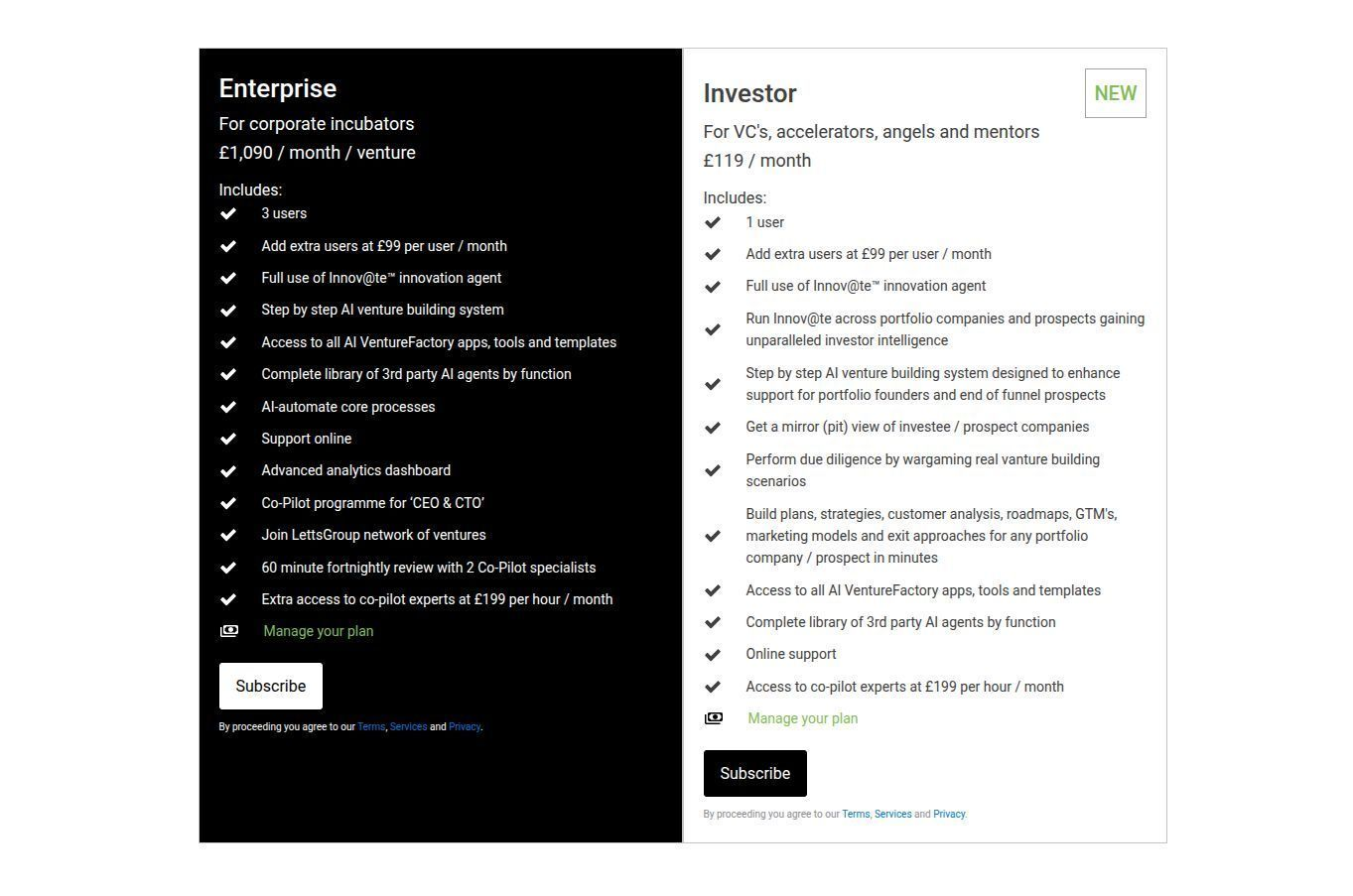
Innov@te™ Agent Access: LettsGroup’s flagship AI venture strategist, now deployed across your portfolio and pipeline.
Real-Time Strategy Lab: Build venture plans, growth models, and GTM frameworks in under 10 minutes.
Live ‘Pit View’: A mirror into your startups’ operational layers - and a tool to shape them.
Third-Party AI Agent Library: Curated agents for marketing, sales, finance, ops, and more.
Collaboration & Support: Online AI assistance and team-based workflows.
Priced at £119/month for single users, with £99/month for additional team seats, the Investor plan delivers boardroom-level strategy to firms of any size - making it a compelling new tool for VCs, angel syndicates, family offices, and operator-investors.
LettsGroup’s AI VentureFactory is already trusted by a growing base of startups, scale-ups, and innovation labs. With Investor , the platform now delivers on the other side of the table - where capital meets creation.
Start building smarter today at letts.group/pricing.
Peter Prince - [email protected]
—ENDS—
We are publishing this definitive guide to new-style venture building section by section, week after week, over the coming weeks - starting today. It's the ultimate guide for startup founders, investors and advisers.
Venture building is the process of taking an idea and developing it into a successful, scalable business. Traditionally, this process has been highly artisanal and ad hoc, often relying on the intuition and heroic efforts of founders. Unfortunately, the outcomes of the traditional approach are sobering: around 60% of startups in the UK fail within their first three years, with only about 42% surviving five years. Globally, the picture is similar - the conventional venture model accepts that perhaps one in ten startups will succeed on a large scale, while the rest falter. These high failure rates point to a fundamentally broken process for building and scaling new ventures. In short, too many resources are wasted and too many good ideas never reach their potential under the old model.
Why does traditional venture building struggle? One core issue is that each startup “reinvents the wheel.” Founders typically must learn how to build a company through trial and error, discovering what works in product development, go-to-market, team building, and financing largely on their own. Little of this hard-won knowledge is codified or transferred to others. This leads to massive inefficiencies and repeated mistakes across the startup ecosystem. Another issue is an excessive focus on short-term outputs (like getting a minimal product and first customers) without developing the underlying systems and operations needed for long-term scale. This myopic focus means many startups flame out when it’s time to scale up, as they lack the infrastructure to support growth.

Enter “new style” venture building - an AI-driven, automation-enabled approach that aims to fundamentally improve the venture creation process. In contrast to the ad hoc traditional method, this new software-driven approach treats venture building as a disciplined, repeatable process - more like manufacturing than alchemy. Just as Henry Ford revolutionised car production with the moving assembly line, the new style of venture building applies automation, data, and process engineering to systematically take startups from idea to scale. Advanced technology (especially artificial intelligence) is leveraged at every stage to reduce manual effort and human error. The goal is to double or even triple venture success rates by eliminating guesswork and bringing science to the art of entrepreneurship.
Crucially, AI-driven venture building isn’t just an incremental tweak - it promises a paradigm shift for how startups are built. It involves using AI tools and software platforms to guide founders through proven frameworks, automating routine tasks, and augmenting human decision-making with data-driven insights. This guide provides a comprehensive look at this new style of venture building. We will compare it to traditional methods, explore a leading example (LettsGroup’s AI VentureFactory and Innov@te™ methodology), and examine how automation-enabled scaling changes the economics of startups. We’ll discuss strategies to overcome scaling challenges, the tech stack needed for automation-first growth, and implications for venture capital investors. We’ll also look at case studies of startups that scaled rapidly with small teams thanks to AI and automation, and peer into the future where venture capital itself may operate as a platform.
The promise of AI-driven venture building is a startup ecosystem where a small, agile team can achieve what used to require an army of employees and massive capital. By the end of this guide, entrepreneurs and investors will understand how to leverage this approach to build more resilient, scalable ventures - and perhaps revolutionise the innovation economy in the process.
Traditional venture building has often been likened to navigating uncharted waters with no map - each startup finds its own way, and many sink. In the current ad hoc, artisanal approach, success depends heavily on the founder’s personal hustle, luck, and ability to learn on the fly. There is typically no repeatable blueprint; one founder might obsess over product features while another focuses on sales, and each builds their company with unique, improvised processes. This artisanal model leads to huge variability in outcomes and a low signal-to-noise ratio in terms of what works. As noted in one analysis, building startups today remains “largely unchanged from decades past - reliant on founder intuition, trial-and-error methodology, and highly variable approaches,” creating limitations that perpetuate high failure rates. In most industries, such a 90% failure rate would be unacceptable, but in startups it has long been considered the cost of doing business.
By contrast, the AI-driven, automation-first approach to venture building is about moving from craft to manufacturing discipline. Instead of every startup reinventing processes, the new style codifies the venture-building journey into defined stages, steps, and best practices. For example, LettsGroup’s Innov@te™ framework encapsulates the process from idea to exit in 7 stages, 49 steps, each with sub-steps and checklists. This provides a standardised roadmap that any startup can follow, reducing reliance on individual gut feel. Knowledge that was once tacit and founder-dependent is made explicit and shareable. In effect, the new model creates an “assembly line” for startups - with ideation, validation, product development, market entry, growth, and even exit strategy all defined as repeatable sequences. Just as an automotive factory has a predictable process to ensure quality output, an AI-driven venture factory aims to produce viable startups with far more consistency than the old artisanal approach.
In essence, the traditional method is like artisan craftsmen hand-building custom cars (beautiful when it works, but expensive and failure-prone), whereas the AI-driven method is like a well-oiled factory assembly line for ventures. The latter doesn’t eliminate creativity - entrepreneurs still come up with innovative ideas - but it provides a process infrastructure to execute those ideas more reliably. This shift is akin to moving from building one-off prototypes to a repeatable manufacturing process for startups.

Notably, the venture studio model that emerged in recent years was a precursor to this new style. Venture studios brought more systematic company creation by generating ideas in-house and providing shared resources to launch multiple startups. However, venture studios often still rely on significant human involvement and bespoke efforts for each venture. The AI-driven venture factory takes this a step further - fully tooling the process with software and AI so that much of the venture building can be automated or centrally managed. For example, a venture studio might have advisers and templates to help startups, but an AI venture factory will have an actual software platform that executes tasks (like automatically running marketing campaigns or generating financial models) and guides the team through every step. It’s the difference between offering advice and providing an integrated machine that does the heavy lifting.
Further, a new style venture building software platform is considerably more cost effective and empowering than traditional venture studio body shops.
To summarise, the new style of venture building dramatically contrasts with the old: it is systematic where the old way is haphazard, data-driven where the old is intuition-driven, and platform-based where the old is individual-based. This difference matters because it attacks the root causes of startup failure. High failure rates are not simply a law of nature – they result from the inefficiencies and knowledge gaps of the traditional approach. By addressing those with structured methods and AI assistance, new style venture building hopes to create a world where startups succeed far more often, with less waste of time and capital in the process.
One of the leading exemplars of this new venture building paradigm is LettsGroup, a UK-based venture group that has built what it calls an AI VentureFactory platform powered by its Innov@te™ methodology. LettsGroup’s approach provides a concrete case study in how to implement AI-driven, automation-first venture building.
At the heart of LettsGroup’s model is the Innov@te™ methodology, which is essentially a detailed playbook for venture building. As mentioned, it consists of 7 core stages, 49 steps and hundreds of sub-steps, covering the entire journey from ideation to exit. The seven stages are defined as: (1) Creativity, (2) @HA Idea (a validated “aha” idea), (3) Concept, (4) Market Entry, (5) Market Development, (6) Market Dominance, and (7) Exit. This sequence starts from the spark of an idea and progresses through building a product, entering the market, scaling up, achieving leadership in the market, and finally preparing an exit (such as an acquisition or IPO). Each stage has specific objectives and checkpoints. For example, Market Entry would involve launching the product to early customers and iterating the go-to-market strategy, whereas Market Development would focus on expanding customer acquisition channels and refining the business model for growth.
What makes Innov@te more than just a static manual is that LettsGroup has turned it into a dynamic software platform - the AI VentureFactory. The AI VentureFactory is a suite of integrated apps, tools, and AI assistants that together function as a co-pilot for startup teams. It guides entrepreneurs through each of the 49 steps with templates, checklists, and AI-driven recommendations. For instance, in an early step the platform might prompt the founder to conduct market research, and even provide an AI tool to perform that research (scouring data or competitor info). Later, in a product development step, the platform might include a project management module pre-loaded with agile templates or user testing protocols. Everything is tied into one system so that the venture’s progress is tracked and each step feeds into the next.
Importantly, the AI VentureFactory doesn’t just advise - it automates and executes many tasks. LettsGroup describes it as a “hybrid AI suite” providing integrated apps for things like marketing, CRM (customer relationship management), productivity, project management, issue tracking, investor relations and more. For example, the platform can automate marketing campaigns using AI content generators, manage the sales pipeline through a CRM integrated with communication tools, and keep financial records up to date - tasks that normally would require hiring multiple roles or even agencies can be handled by the platform’s tools. An integrated AI chatbot assistant is even available (LettsGroup’s “How to AI Innovate!” bot) to answer founders’ questions and provide startup intelligence drawn from the venture factory’s knowledge base. In short, LettsGroup’s platform is like having a full operations team and mentor network in software form, available on-demand. Some have even called it the AWS of venture building!
The combination of Innov@te methodology and the AI VentureFactory platform yields what LettsGroup calls a “venture manufacturing system.” In fact, they explicitly compare it to a production system akin to ERP (Enterprise Resource Planning) but for startups – humorously dubbed “Innov@te VRP (Venture Resource Planning)”. The platform manages the process flows (the 49 steps), the data, and even the work allocation akin to an assembly line for new ventures. By doing so, it aims to reduce the cost of venture building, accelerate growth, and double success rates relative to industry norms. LettsGroup has stated the goal of helping ventures go from “zero to IPO” faster, more predictably and in a capital-efficient manner.
It’s instructive to see how LettsGroup’s approach differs in practice from traditional incubation or accelerator programs. A typical accelerator might provide a 3-month program of mentorship, some template documents, and a small investment for a considerable chunk of your company. LettsGroup’s VentureFactory, on the other hand, is positioned as an ongoing subscription-based co-pilot for building a company. In fact, LettsGroup offers tiered subscription plans for startups to use its platform: e.g. a Startup Lite plan starting at just £295 per month, with further plans for more advanced startups needing more features and support. This “startup building as a service” model shows how venture support is productised in the new approach. Instead of spending (or wasting) millions in trial-and-error, a startup might pay a predictable monthly fee to get the scaffolding it needs to grow. This aligns incentives as well - the venture factory is motivated to help the startup succeed so that it remains a paying (and growing) customer through the stages.
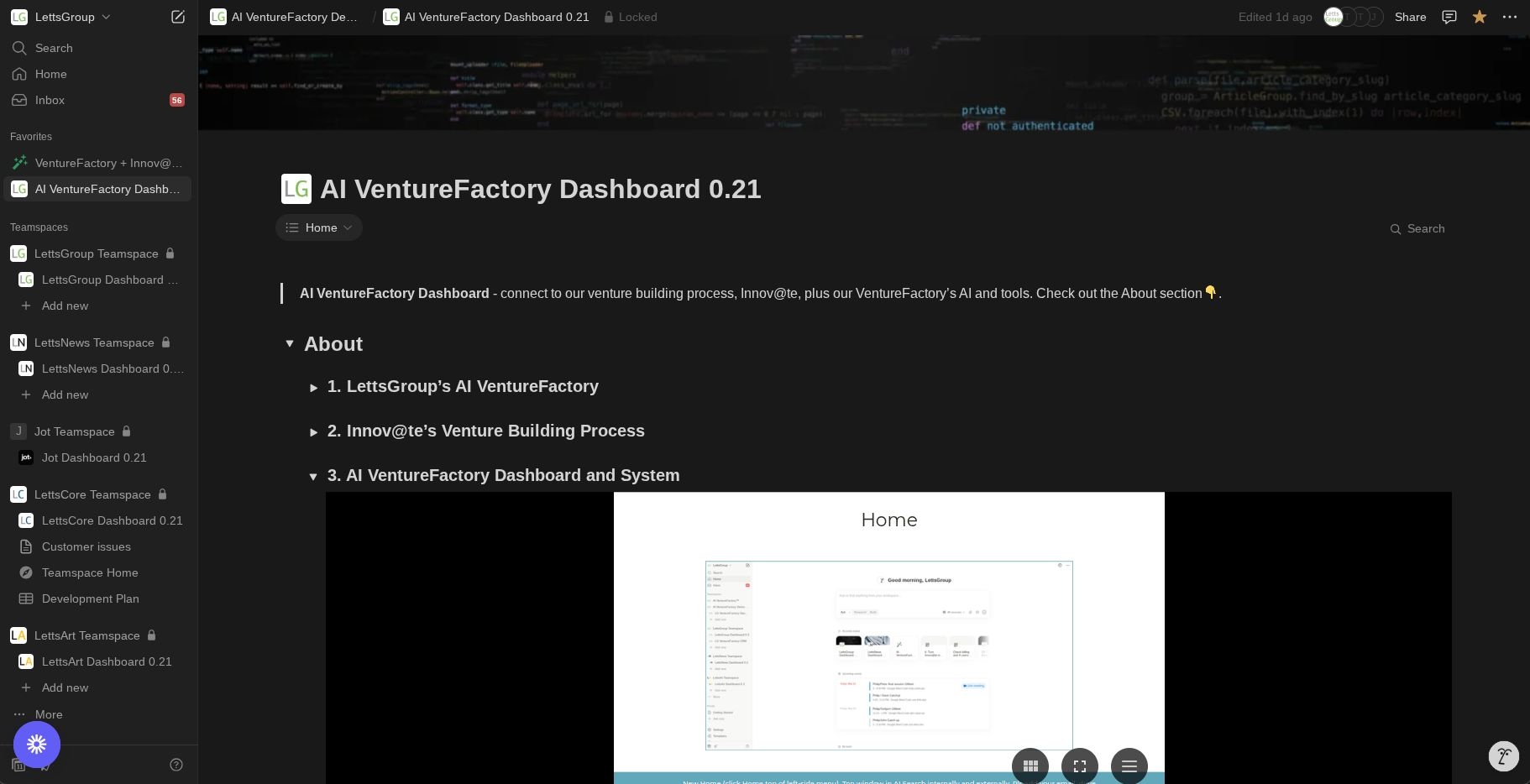
LettsGroup has already used its AI VentureFactory internally to build and launch several of its own “branded ventures.” These include LettsCore (a content management blockchain), LettsNews (an AI-powered “newsroom tech for everyone”), LettsArt (an AI co-code platform for the art world), and LettsSafari (a nature-tech venture). Each of these was developed using the same Innov@te methodology, demonstrating its versatility. By dogfooding their platform on their own ventures, LettsGroup could refine the process. They report that previous ventures they built (even before the AI platform) - such as Beenz (an early digital currency), SurfKitchen (mobile phone-top software), and Maistro (a business services marketplace) - achieved over $1 billion in combined peak valuation. Those experiences fed into the Innov@te framework as well. Now, with the AI VentureFactory, LettsGroup not only builds its own companies but also “co-pilots” external startups and corporate ventures on the platform. Essentially, they have turned venture building into a service that others can tap into.
A few aspects of LettsGroup’s methodology stand out as particularly innovative in venture building:
Size Zero Philosophy: In parallel with Innov@te, LettsGroup developed what they call a “Size Zero” design philosophy for ventures. This philosophy emphasises designing startups to be highly efficient and automated from day one - essentially building a scaled business model in miniature . The idea is to architect the company (its processes, cost structure, and tech) such that it can scale gracefully without massive complexity or cost explosion. For example, a Size Zero approach might impose frugality and automation early: only 5 staff managing what others would delegate to 50, by relying on software and automation (AI). LettsGroup uses this philosophy to help founders embed lean, agile, and cost-controlled designs into their ventures from the start. Combined with the Innov@te process, it acts like a modern just-in-time and continuous improvement system, analogous to how manufacturing evolved with techniques like Kanban or Six Sigma - but applied to growing a business.
Integrated Toolset and Data: The venture factory platform doesn’t just outline steps; it provides the tools to execute each step. LettsGroup’s platform integrates proprietary and third-party apps for everything from marketing automation to issue tracking to fundraising. All these tools produce data that feed into a unified dashboard, allowing real-time tracking of a venture’s KPIs and progress. This addresses a common blind spot in traditional startups where different tools are siloed (spreadsheets here, Trello boards there, etc.). By operating on one platform, a venture factory can apply AI analytics across the venture - spotting risks (e.g. if user engagement metrics are trending down) or opportunities (e.g. a marketing channel shows exceptional ROI) faster than a human team could. It essentially gives a bird’s-eye view of the startup’s health, something investors and founders typically struggle to get in real time.
Systematic De-risking: The Innov@te methodology systematically addresses common failure points. For instance, it enforces rigorous market validation in the Concept stage to ensure there is genuine demand before heavy scaling. It has steps for funding readiness - essentially preparing the startup to cross the “valley of death” between initial funding and Series A by ensuring the fundamentals (traction, metrics, pitch) are strong. By baking in these checkpoints, the venture factory tries to de-risk ventures early and continuously, rather than the traditional approach of discovering a fatal flaw only when it’s too late (e.g. running out of cash unexpectedly, or discovering no product-market fit after a big launch).
LettsGroup’s AI VentureFactory illustrates how a venture builder can become a platform and process owner instead of just a mentor or investor. Early indications suggest such systematic support can improve outcomes significantly. As noted, LettsGroup believes its approach can achieve on the order of 20% big-success rate (1 in 5) and up to a 90% lower cost to build startups. Even if those exact figures are aspirational, it’s clear that ventures built with robust methodologies have a better shot than those relying purely on improvisation. By reducing the cost and increasing the success odds, platforms like the AI VentureFactory may well alter the economics of entrepreneurship - making it feasible to build substantial businesses with far less capital and time than before.
In the subsequent sections which we will publish over the next few weeks, we delve into those economic changes and other implications of automation-enabled venture building. But the big takeaway from LettsGroup’s example is this: venture building can be systematised. Much as industries from manufacturing to software development have benefited from standard processes and automation, so too can the process of creating new companies. The Innov@te methodology and AI VentureFactory are a concrete embodiment of the “new style” venture building - blending human creativity with AI-powered execution to produce ventures better, faster, and cheaper.
Next section - The New Economics of Venture Building.
If you are an entrepreneur with a tech or digital venture, sign up for LettsGroup's AI VentureFactory today.
LONDON, June 4th, 2025 – LettsGroup (www.Letts.Group) announces the public launch of its VentureFactory, a groundbreaking AI-native venture building platform, that has demonstrated the ability to reduce startup costs by up to 90% while significantly accelerating time-to-market and time-to-scaling. After more than two years of development and private beta testing and with several startups now successfully scaling, the platform will be available to any tech or digital startup from 5th June.
The AI VentureFactory represents the third generation of LettsGroup's proven Innov@te™ venture building system, which has powered the growth of tech unicorns and led to a number of successful exits. The platform combines AI-powered apps, tools and templates, expert guidance, and a structured process designed to help founders navigate the complex startup journey efficiently.

"Tech entrepreneurs face hundreds of critical decision points that can make or break their ventures," said Philip Letts, CEO of LettsGroup. "Our AI VentureFactory provides the process, structure, tools, and insights to optimise each step of the journey. We've eliminated the critical knowledge gaps that derail so many promising startups."
The platform's private beta has demonstrated impressive results across a number of tech and digital ventures, including an AI software startup helping manage, distribute and sell art better with 1,000 art galleries using its platform and a nature-tech startup with nearly 700 subscribers that launched just a few months ago. All of the early ventures have reached the Seed stage with sophisticated hi-tech products and some are already generating revenue.
LettsGroup's AI VentureFactory is supported by a team of Co-Pilot experts specialising in strategy, technology, product design, marketing, business development, and fundraising. The senior team has collectively helped build and lead dozens of groundbreaking tech companies worth over $50 billion in aggregate. The platform's AI, its agents and tools automate planning, strategy, research, pricing, forecasting, fundraising and much more. Its AI-powered apps include work tools and collaboration, planning tools, CRM, content marketing and AI note-taking,
The platform's track record of success leverages earlier versions of the Innov@te system to become the first fully fledged venture building agent. Innov@te in its earlier versions helped create one of the UK's first international internet unicorns (raising $80M before acquisition) and one of the first mobile software companies developing smartphone app stores (sold to Fujitsu for approximately $100M).
LettsGroup is excited to open its doors to tech and digital startups with its groundbreaking AI-native venture building platform that builds, scales and optimises companies at every stage. For accelerator companies, pre-Seed startups and venture capital portfolio companies looking for a system-driven, accelerated approach to venture building, the AI VentureFactory is a compelling choice.
Founders interested in leveraging the AI VentureFactory to power their startup journey should visit www.Letts.Group to sign up and gain access from June 5th.
Media Contact:
Peter Prince
+44 7545 967834
[email protected]
www.Letts.Group
LettsGroup's AI VentureFactory launches on June 5th for external ventures - view announcement here. This AI-native platform slashes startup building costs by up to 90% through Seed stage while dramatically accelerating time-to-market and boosting operational efficiency. Founders spend less time on operational overhead and more time building products customers actually want.The platform delivers the same venture building advantages that powered our branded ventures - now available to independent founders and investors. With integrated AI agents, tools, and applications purpose-built for tech startups, LG's AI VentureFactory transforms how digital ventures scale from concept to market to exit.
Ready to build better, faster and cheaper? Sign up here - whether you're a founder or investor looking for your next competitive edge.

LettsCore is readying for market launch in Q3 with its first enterprise customer fully rolled out. This month delivered critical technical milestones that position us to capture the emerging blockchain content management market:
Core Infrastructure Complete: We've implemented off-chain content storage with enhanced transaction histories that layer LettsCore-specific data onto Solana's blockchain records, creating unprecedented transparency and audit capabilities.
Revenue Systems Live: Our subscription and micropayment infrastructure has passed comprehensive edge-case testing, enabling multiple monetisation pathways from day one.
AI-Powered Product Suite: We've packaged three market-ready solutions: AI Search, automated social media content generation and distribution, and MCP extensions that integrate seamlessly with existing enterprise workflows.
Enterprise-Ready Foundation: Our proprietary AI toolkit now auto-generates testing frameworks and maintains comprehensive documentation, significantly reducing customer onboarding time and support costs.
The opportunity is clear: We're entering the market in Q3 as the first mover in blockchain-native content management, with proven enterprise demand and a customer already scaling our platform. This positions LettsCore to capture significant market share as enterprises seek transparent, decentralised alternatives to traditional content management solutions.
LettsNews has achieved full-stack AI automation across its newsroom platform - automatically generating content, stories, images, and metadata while eliminating manual workflows. This complete automation should accelerate content production by 10x while reducing operational costs for independent news professionals and media organisations. The platform's intelligent social-promotion system now also integrates Mastodon with AI-driven distribution, maximising reach across decentralised networks.
An advanced analytics dashboard launching Q3 will deliver real-time performance insights and predictive content recommendations. And the breakthrough AI discovery engine identifies existing relevant content or generates new material on-demand, creating a self-sustaining content ecosystem. With public beta launch scheduled for July, LettsNews is positioned to capture the $50B+ media technology market by delivering the industry's most comprehensive AI-native newsroom solution to independent journalists, PR agencies, and content managers seeking competitive advantage through automation.

LettsArt has hit its most critical milestone to date with 1,000 galleries now powered by the AI no-code software platform for the art world. The team has been hard at work developing LettsArt 2.5 slated for release in Q3. It boasts a bunch of exciting new features including:
LettsSafari's organic subscriber growth accelerated following increased weekly 'from the park' content on LettsSafari+. This momentum will drive Q3 platform expansion of our rewilding mediatech offering, enhanced community features, and deeper influencer partnerships. Our growing subscriber base positions us to start groundbreaking collaborations with landholders by year-end - working to create the first LettsSafari-branded rewilding safari park venues across Western markets. This integrated model transforms traditional conservation into scalable, revenue-generating entertainment destinations while capturing the rapidly expanding eco-tourism sector.

Jot+ becomes our inaugural non-branded venture, leveraging the AI VentureFactory from concept to exit. This pre-Seed consumer tech startup is reimagining a massive market opportunity through AI-first innovation. With proven founders tackling a multi-billion dollar category, Jot+ represents exactly the type of high-potential venture our platform was built to accelerate. Coming soon...
We highlight just a few ventures in each monthly edition of LettsGroup's NewsFlash. To explore other companies using LettsGroup's AI VentureFactory go to LettsGroup/ventures.
Today, we explore the evolving landscape of venture building, based on LettsGroup's analysis that challenges the traditional notion that founders must transition to professional managers for companies to scale successfully. It argues that the "Founder DNA," characterised by traits like extreme self-belief and persistence, is crucial for innovation and higher valuations, citing data on unicorn performance amongst others. The text analysis highlights how technology, particularly AI and automation, enables "Founder Mode at scale," allowing entrepreneurs to maintain control while achieving operational efficiency through systematic methodologies and platforms like the AI VentureFactory, potentially democratising entrepreneurship and transforming venture economics.

The venture capital ecosystem finds itself at an inflection point. For decades, the received wisdom has been unequivocal: as startups scale, founders must yield to professional managers; those MBA-wielding executives who know how to build "proper" organisational structures. Yet the technology sector's most successful companies tell a strikingly different story. From Steve Jobs' return to Apple to Elon Musk's simultaneous leadership of multiple ventures, the evidence increasingly suggests that conventional management orthodoxy may be catastrophically wrong.

This debate burst into Silicon Valley consciousness with Paul Graham's provocative essay on "Founder Mode," which articulated what many entrepreneurs had long suspected: the standard playbook for scaling companies might be the very thing killing them. The essay struck a nerve precisely because it challenged the fundamental assumptions underpinning decades of business school teaching and venture capital advice.
The stakes couldn't be higher. With traditional venture capital success rates hovering around a dismal 10% , and corporate ventures performing even worse at 5-7%, the industry desperately needs new approaches. Enter a new generation of technology-enabled methodologies that promise to resolve the founder-manager dichotomy while preserving the entrepreneurial DNA that drives innovation.
The numbers tell a compelling story that management consultants might prefer to ignore. Defiance Capital's comprehensive analysis of 972 unicorns and their 2,467 founders reveals that founder-led companies achieve median valuations 40% higher than those transitioning to professional management through Series C funding. Even more striking, founder-led IPOs command average multiples of 8.2x revenue versus 5.7x for their professionally managed counterparts.
But why do founders consistently outperform seasoned executives? The answer lies in what researchers term "Founder DNA", a unique psychological profile that drives exceptional performance. The Founder Institute's analysis of over 100,000 global entrepreneurs identifies three critical traits: unlimited self-belief (present in 89% of unicorn founders), absence of fallback options (78%), and "chip on the shoulder" motivation (72%). These characteristics manifest as 3.4x higher risk tolerance and 2.8x greater persistence through adversity compared to traditional managers.
Perhaps most intriguingly, 62% of US unicorns include immigrant founders - individuals whose "no plan B" mentality correlates powerfully with sustained entrepreneurial leadership. These founders don't just think differently; they operate in fundamentally distinct ways. Where corporate managers optimise for predictability, immigrant founders embrace chaos as opportunity. Where MBAs build processes, founders build products. Where executives manage risk, entrepreneurs manufacture momentum.
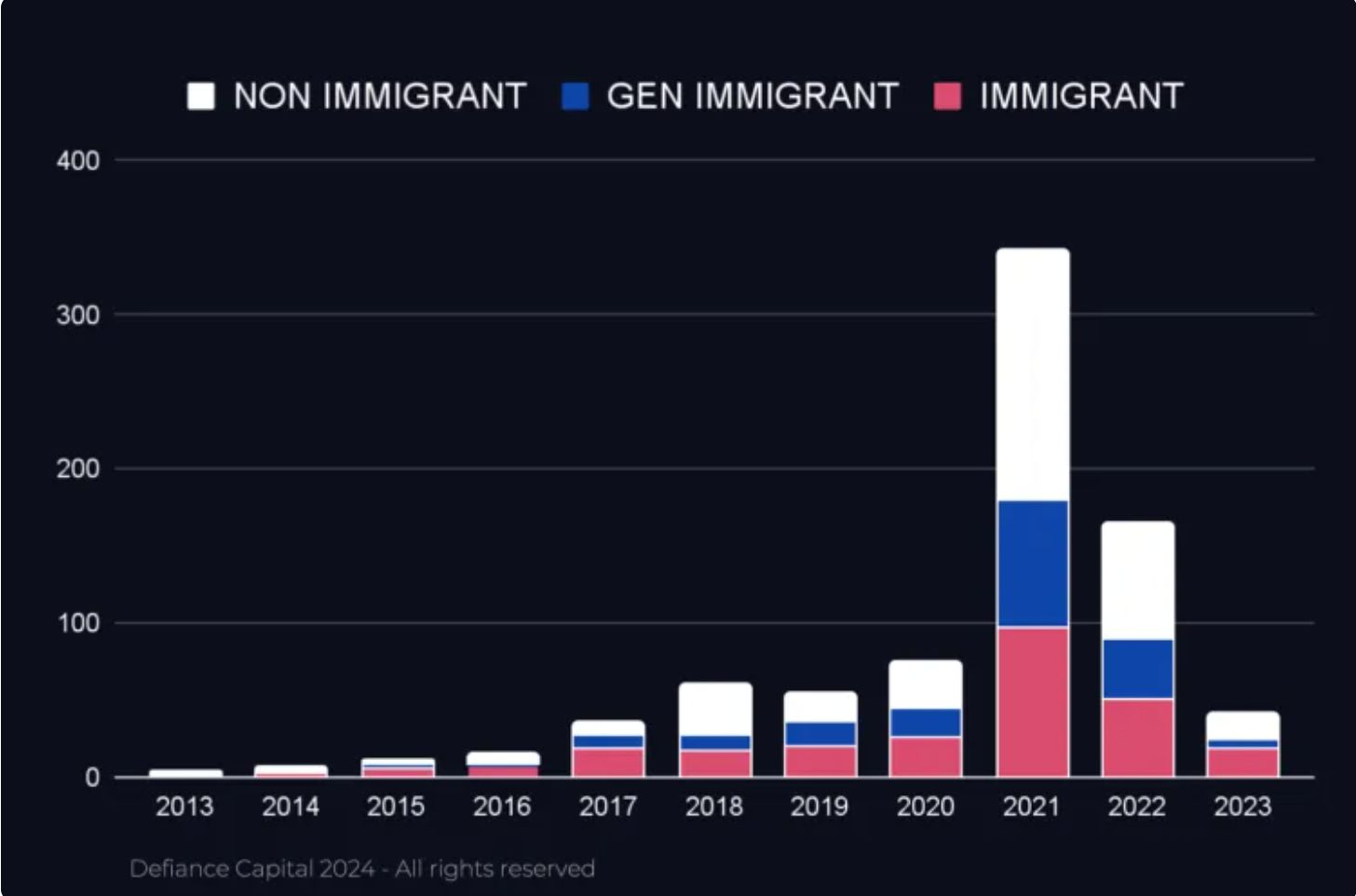
The network effects amplify these advantages exponentially. Startup Genome' s research demonstrates that founders with high Global Connectedness scores - those with five or more connections to top-tier ecosystems - achieve 3.25x higher scaling probability. It's not just who you know; it's how founder relationships compound over time, creating what venture capitalist Fabrice Grinda calls "an unshakeable belief in themselves" that enables persistence where rational actors would retreat.
The traditional management playbook reads like a prescription for startup suicide. Consider the predictable failure patterns: innovation suffocation (67% of founders report this after transitioning to professional management), premature process implementation (54%), cultural misalignment (71%), and timing mismatches (49%). These aren't random failures; they're systematic dysfunctions arising from fundamental incompatibilities between corporate management and entrepreneurial reality.
Brian Chesky's experience at Airbnb exemplifies this tension. Following conventional wisdom nearly destroyed the company before Chesky embraced what he learned from Steve Jobs: founders must stay involved in the details that matter. As Chesky notes, founders are "biological parents" of their companies, maintaining emotional and intellectual connections that hired executives rarely match. This intimate knowledge enables rapid pivots, bold decisions, and sustained innovation that characterise breakthrough companies.
The founder-manager divide cuts particularly deep along gender lines. Female founders face disproportionate pressure to hire professional management, with 73% reporting investor demands for "experienced executives" compared to 41% for male founders. This disparity contributes to women comprising only 17% of US unicorn founders despite demonstrating equivalent success rates when controlling for funding access and industry selection.

What makes this particularly troubling is how identical behaviours receive different interpretations based on gender. A male founder's hands-on involvement gets labelled "passion"; a female founder's similar engagement becomes "micromanagement." Silicon Valley executives noted after Graham's essay that female entrepreneurs often lack "permission" to operate in founder mode - a double standard that constrains precisely the leadership characteristics that drive exceptional outcomes.
Just as the founder-manager debate reaches fever pitch, technology offers an unexpected resolution. Artificial intelligence and automation increasingly enable what LettsGroup terms "Founder Mode at scale" - maintaining entrepreneurial characteristics whilst achieving operational sophistication that once required armies of middle managers.
The numbers are staggering. LettsGroup's AI VentureFactory reports reducing average costs to seed stage from the industry-standard $2 million to below $100,000; a 95% reduction achieved through systematic process automation and AI-powered decision support. This isn't merely about cost efficiency; it's about democratising entrepreneurship by enabling founders to maintain control through extended runway periods that would traditionally force premature delegation.
The AI VentureFactory exemplifies this new paradigm. Built on 15 years of venture development experience, the platform encompasses seven core stages, 49 discrete steps, and hundreds of sub-steps that transform traditionally tacit founder knowledge into reproducible processes. Rather than replacing founder intuition, it amplifies it - automating routine operations whilst preserving the creative chaos that drives innovation.
Real-world results validate the approach. Five ventures built using the methodology have reached seed stage, including LettsCore (blockchain infrastructure), LettsNews (AI-powered media technology), and LettsArt (digital marketplace systems). These aren't incremental improvements but step-function advances: 2.4x faster development cycles, 60% lower customer acquisition costs, and dramatically improved capital efficiency.
The implications extend far beyond individual ventures. If systematic approaches can consistently double success rates, from traditional 10% to targeted 20%, the aggregate impact on venture returns could transform industry economics. More capital would flow to early-stage ventures, more founders could pursue ambitious visions, and more innovations would reach market.
The founder-manager dichotomy manifests differently across global markets, creating fascinating cultural variations. Silicon Valley's risk-embracing ethos naturally favours founder leadership, whilst European markets' regulatory complexity and cultural risk aversion traditionally support professional management. Asian markets split along regional lines: Singapore and Israel embrace founder models whilst Japan and Korea favour hierarchical structures.
Yet technology-enabled approaches offer particular promise for markets outside traditional innovation hubs. The AI VentureFactory's 90% cost reduction proves especially transformative for emerging economies with limited venture capital. Suddenly, entrepreneurs in São Paulo or Lagos can access venture-building capabilities previously exclusive to Silicon Valley, potentially unleashing global innovation waves.
The key insight: technology enables cultural translation of founder principles across diverse contexts. European entrepreneurs can leverage systematic frameworks to satisfy regulatory requirements whilst maintaining founder control. Asian founders can use platforms to bridge hierarchical expectations with entrepreneurial flexibility. The AI VentureFactory doesn't impose Silicon Valley culture; it adapts founder mode principles to local realities.
This cultural adaptability matters because different markets require different approaches. What works in San Francisco's freewheeling environment needs modification for Berlin's process-oriented culture or Tokyo's consensus-building traditions. Systematic methodologies provide the translation layer, enabling founder characteristics to flourish within varying cultural constraints.
Looking ahead, traditional organisational structures appear increasingly obsolete. Research suggests future billion-dollar companies might operate with 10-20 core employees, leveraging AI for functions previously requiring hundreds of staff. This isn't downsizing, it's a fundamental reimagining of how companies create value.
The implications ripple across entire economies. Educational institutions face existential questions about MBA programmes built around industrial-era management principles. Governments must reconsider regulatory frameworks designed for hierarchical corporations. Venture capitalists need new evaluation criteria that assess founders' ability to leverage technology rather than plans for management succession.
Traditional performance metrics such as efficiency ratios, hierarchical reporting structures and predictable quarterly results prove inadequate for innovation-driven organisations. Emerging scorecards prioritise adaptability, learning velocity, and market responsiveness. These new measures favour founder characteristics over management orthodoxy, technology leverage over human hierarchies, and systematic innovation over process optimisation.
The shift demands new thinking from all ecosystem participants. Investors must recognise that the best founders might never "graduate" to professional management. Accelerators should teach systematic innovation rather than traditional scaling. Policy makers need frameworks supporting flat, automated organisations rather than assuming corporate pyramids.
The founder versus manager debate ultimately represents yesterday's question. Tomorrow belongs to leaders who combine founder orientation with systematic execution, maintaining vision and adaptability whilst leveraging AI and automation for operational excellence. This synthesis transcends traditional categories, creating new possibilities for venture building and scaling.
The evidence overwhelmingly supports sustained founder leadership enhanced by technological capabilities. Platforms like LettsGroup's AI VentureFactory demonstrate how systematic methodologies can preserve entrepreneurial DNA whilst achieving operational sophistication. The most successful ventures won't choose between founder and manager modes; they'll synthesise both through technology.
This evolution requires deliberate choices. Founders must develop new competencies in AI utilisation, systematic thinking, and digital organisation building. Investors must fund leaders who refuse traditional transitions to professional management. Educators must reimagine curricula for technology-augmented entrepreneurship.
As venture building evolves from craft to system, the distinction between founder and manager modes blurs into irrelevance. Technology enables founder vision and passion to scale without sacrificing operational excellence. The entrepreneurs who master this synthesis, leveraging platforms like the AI VentureFactory whilst maintaining their essential DNA, will define the next generation of transformative companies.
The future belongs not to founders or managers, but to technology-augmented leaders who transcend traditional categories. They'll build tomorrow's defining enterprises not by choosing between entrepreneurial chaos and managerial order, but by synthesising both through systematic innovation. In this new paradigm, Founder Mode isn't just preserved. It's amplified, systematised, and unleashed at previously impossible scales.
After years of refining our venture-building process through our Innov@te™ methodology, LettsGroup is excited to announce that our AI VentureFactory, powered by Innov@te, will be available to external ventures starting June 5th. As we prepare to open our doors, we wanted to share our impressive track record of success and the measurable results we've achieved for startups in our ecosystem.
The AI VentureFactory represents the culmination of our venture-building expertise, refined across 3 versions of our Innov@te venture building process and used by 15 sector defining tech ventures:
Our initial version helped launch and scale groundbreaking ventures, including:
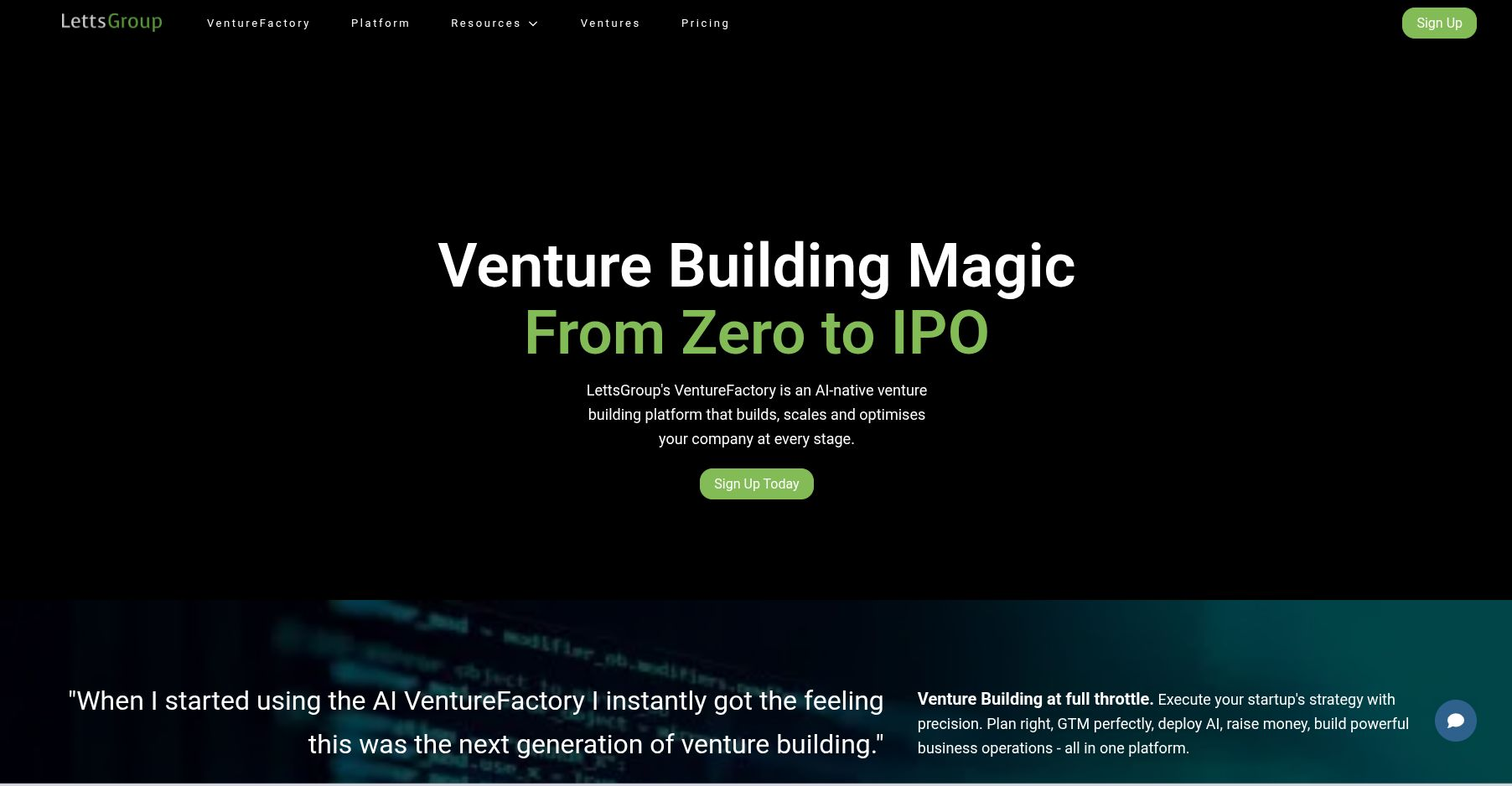
Our second version powered several innovative companies:
For the past three years, we've been developing our next-generation platform, the AI VentureFactory. The results from our private beta have been remarkable:
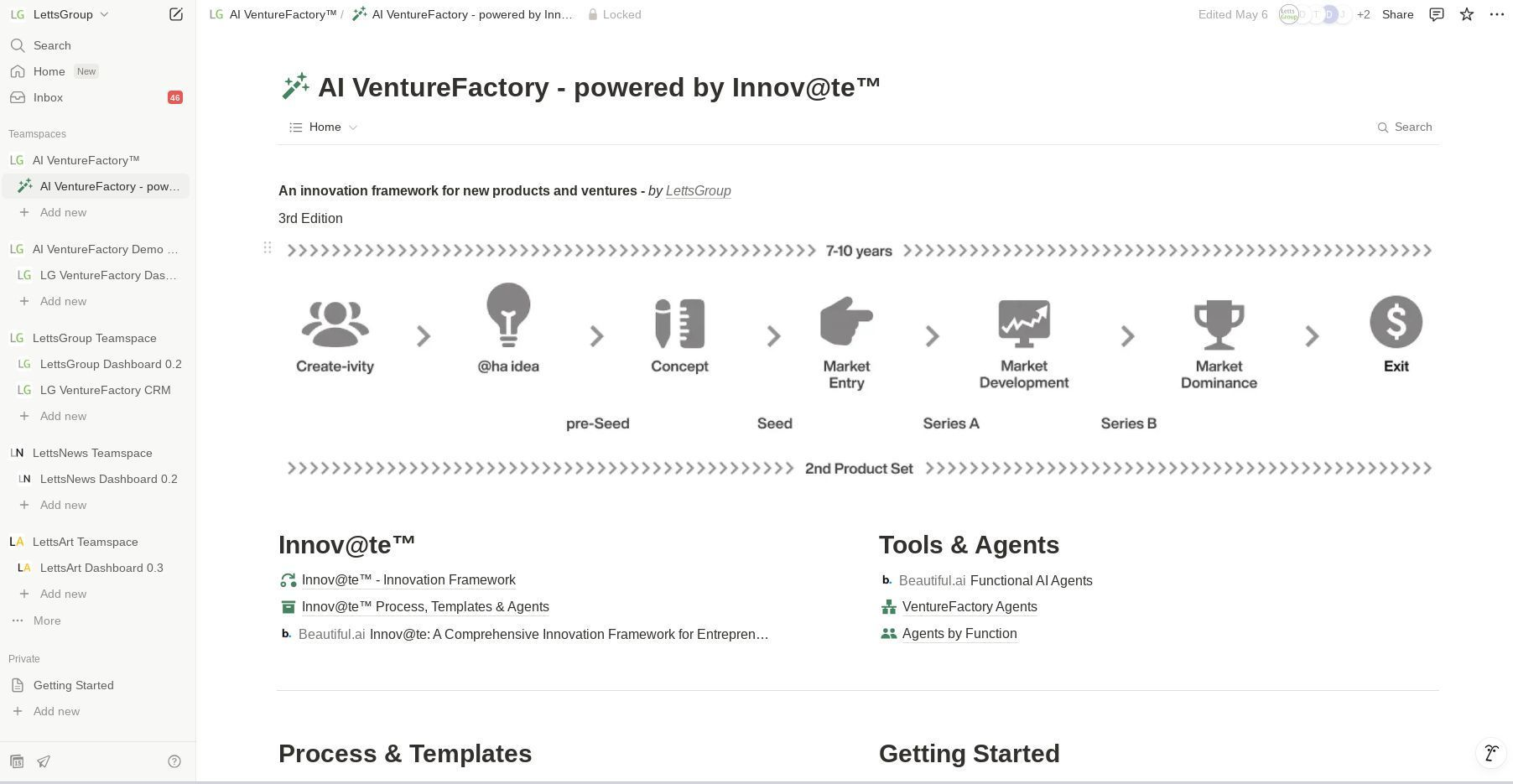
Our AI VentureFactory has demonstrated exceptional performance across several key metrics:

Our five branded ventures showcase the power of our methodology:
A No-Code AI Software Company for the Art World
A Pioneering Nature-Tech Platform
Additional Innovative Ventures
LettsGroup's senior team brings unparalleled expertise to the table:
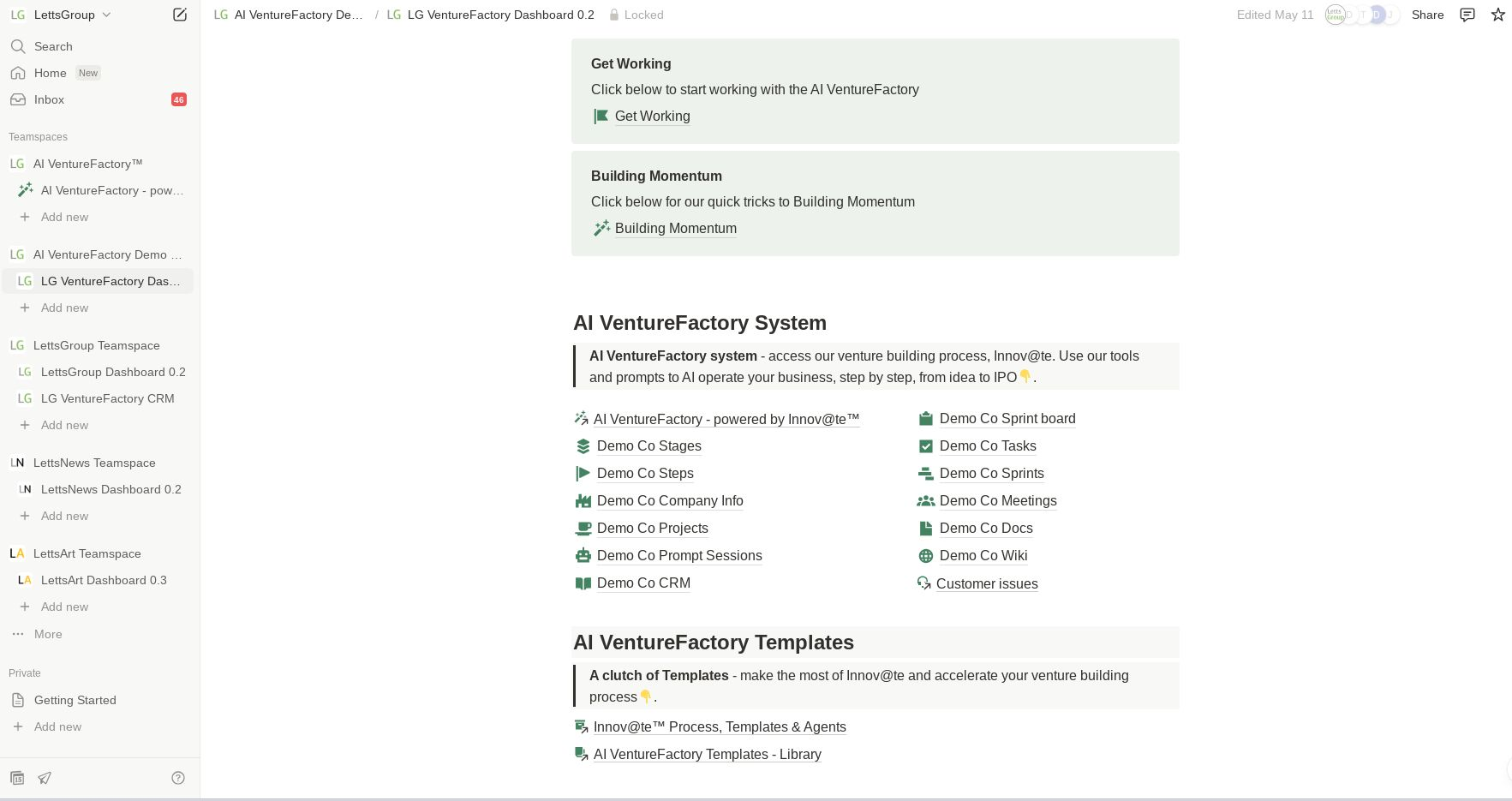
What makes the AI VentureFactory yet more powerful is our comprehensive support system:
As we prepare to open the AI VentureFactory to external startups, we're offering additional benefits to our community:
The true value of the AI VentureFactory lies in its ability to navigate the hundreds of key decision points and challenges that tech startups face. Our platform provides the process, structure, tools, automations, and insights to optimise your journey at every stage, ensuring you're never blindsided by "what you don't know you don't know."
With a track record of 15 companies and dozens of tech entrepreneurs successfully using the Innov@te methodology, and 5 branded ventures already scaling with the new AI VentureFactory, we're confident you can accelerate your startup's success.
We're currently allowing early signup. If you're interested in finding out more about LettsGroup's AI VentureFactory platform or would like more information about our programme go to Letts.Group. Alternatively, sign up today and jump the queue for the June 5th launch at pricing.Letts.Group.
Transform your startup journey with LettsGroup's AI VentureFactory – where innovation meets execution.
The European innovation ecosystem is fundamentally broken. Despite commanding 19% of global R&D investment and housing 43% of the world's premier life sciences universities, Europe has systematically failed to produce technology companies of global significance. This failure is not accidental but structural. It is rooted in a crippling risk aversion that permeates the entire European startup ecosystem. As pre-seed founders, you aren't merely operating within this flawed system; you are actively perpetuating it. Your inability to embrace transformative risk isn't just limiting your company's potential, it's ensuring Europe remains technologically subservient to American innovation for generations to come.#

European startups don't fail because of insufficient technical expertise or inadequate funding ecosystems. They fail because European founders categorically refuse to think beyond incremental improvements and modest market ambitions. It started when Beenz, London’s first fintech sensation and the first global cryptocurrency, moved to New York to scale. When Stripe's Collison brothers needed to build a truly transformative payment infrastructure, they abandoned Europe for Silicon Valley. When Spotify faced the critical scale-up phase, it required American capital and market access to achieve platform status. The pattern is unmistakable and damning.
The market data confirms this systemic deficiency. While American startups routinely target total addressable markets measured in billions, European founders celebrate securing dominance in fragmentary regional markets. Palantir, OpenAI, and SpaceX didn’t emerge from ecosystems that reward cautious, stepwise growth and profit-before-platform - they emerged from systems that demand founders shoot for market transformation or perish trying. Compare this with European "success stories" like Klarna, which spent years building modest payment solutions before finally embracing the high-risk, high-reward buy-now-pay-later model that American competitors had already pioneered.
This pathological timidity manifests in European founders’ obsession with early revenue and premature profitability. Uber sustained billions in losses to establish market dominance; Amazon reinvested profits for over two decades to build an unassailable market position. Meanwhile, European founders proudly showcase "capital efficient" growth models that virtually guarantee they’ll remain subscale relative to American competitors. Monzo and N26 initially celebrated their "responsible growth," only to watch as American fintech companies secured valuations five to ten times higher by aggressively pursuing market share over immediate profitability.
The consequences of this mindset are not theoretical but devastatingly practical. Europe has become the world’s innovation farm team - developing promising technologies only to see them acquired and scaled by American companies when they show signs of genuine breakthrough potential. DeepMind’s acquisition by Google stands as perhaps the most damning example of a world-leading AI research outfit that could have become Europe’s foundational AI champion now serving American strategic interests. This pattern repeats across sectors: Kustomer’s sale to Meta, Skype’s acquisition by Microsoft, and ARM’s sale to SoftBank all represent European innovations ultimately captured and monetised elsewhere.
The Draghi report’s identification of Europe’s "middle technology trap" isn't merely an academic observation. It's an indictment of the founder psychology that pervades the ecosystem. European founders have internalised the region’s regulatory caution and cultural risk aversion, creating companies designed to survive rather than transform. Tesla didn't emerge from a mindset of balanced risk management and incremental market capture; it resulted from Musk's willingness to repeatedly risk bankruptcy to force a transition to electric vehicles. No European automotive startup has shown comparable ambition, despite the continent’s renowned automotive engineering expertise.
This failure of entrepreneurial courage has produced a devastating leadership vacuum. While America has generated multiple generations of visionary founder-leaders from Jobs and Gates to Bezos and Zuckerberg to contemporary figures like Chesky and Altman, Europe has produced precious few comparable figures. This isn’t coincidental but causal. European venture ecosystems systematically select against the psychological profile that produces transformative leaders. Even Stripe’s Patrick Collison has acknowledged that his company could never have achieved its current position had it remained in Europe’s more risk-averse ecosystem.

The path forward requires a fundamental rejection of Europe’s entrepreneurial orthodoxy. Founders must:
Target global market dominance from inception. Revolut distinguished itself precisely by rejecting the regional focus that hamstrung other European fintech startups, immediately building infrastructure for global operations rather than optimising for European regulatory environments.
Embrace extended unprofitability as a strategic weapon. Delivery Hero’s willingness to sustain years of losses to establish market position stands as a rare European example of the approach American startups take for granted.
Design technology platforms with capabilities far beyond current market demands. Adyen’s decision to build payment infrastructure capable of handling transaction volumes 100x their initial market need exemplifies the architectural ambition European startups typically avoid.
Select investors based on risk tolerance rather than operational expertise. Spotify’s decision to partner with American growth investors rather than European venture funds with "sector expertise" proved critical to its survival against Apple Music’s competitive threat.
But even these steps are insufficient unless Europe builds institutions that actively enable and expect this level of ambition from day one. That’s where new models like the AI VentureFactory at LettsGroup point the way forward. Rather than hoping founders will self-correct in a system that punishes risk, the AI VentureFactory is engineered to do what traditional incubators and accelerators will not: build ventures around transformative potential, not incremental feasibility. It systematically removes friction, compresses time to scale, and injects AI-powered ambition into the DNA of every startup it helps create.
The AI VentureFactory doesn’t simply support bold founders - it manufactures them. It challenges conventional European startup thinking by designing ventures for global scale from day one, deploying AI not just as a tool but as a co-founder, and focusing capital and talent on ventures that reimagine entire industries, not just marginally improve them.
The European innovation ecosystem isn’t failing despite its caution - it’s failing because of it. The region’s risk aversion doesn’t protect founders from failure; it guarantees they’ll never achieve transformative success. The existential question for European founders isn’t whether you can create modestly successful companies - the ecosystem already proves this possible. The question is whether you possess the courage and risk-taking conviction to build companies capable of defining technological paradigms rather than merely participating in them.
As Benchmark Capital’s Bill Gurley observed during his European investment tour, “European founders ask how to minimise downside risk; American founders ask how to maximise upside potential.” Until this fundamental psychology shifts - and until new structures like the AI VentureFactory become the norm, not the exception Europe will remain a technological colony: developing innovations for exploitation by American platforms rather than building platforms of its own.
The uncomfortable truth is that Europe doesn’t lack capital, talent, or technical capability. It lacks founders with the audacity to deploy these resources with the singular focus on transformative outcomes that characterise America’s most successful technology companies. This isn’t merely a difference in approach - it represents an existential threat to Europe’s technological sovereignty and economic future. The most patriotic act a European founder can undertake isn’t building a "sustainable" business that creates modest employment - it’s building companies of such ambition and scale that they reshape global markets in Europe’s image.
And if that’s your mission, you don’t need another accelerator - you need a factory for ambition. You need a launchpad built for paradigm shifts. You need to think bigger, risk more, and build what the world doesn't yet know it needs. The next global platform doesn’t have to come from Silicon Valley. It could come from here. But only if you start building like it.
Early stage tech-focused founders can sign up to LettsGroup's AI VentureFactory today. Go to www.Letts.Group.
Today, we sit down to discuss a critical question for the future of European innovation: can Europe do what's necessary to create genuine, successful tech leaders and achieve digital sovereignty? Europe faces a paradox of strong research but lagging high-tech productivity , caught in a "middle technology trap" and hindered by a significant cultural risk aversion that impacts entrepreneurship, investment, and acceptance of failure. How is LettsGroup's AI VentureFactory providing the solution? See more in their recent analysis.
